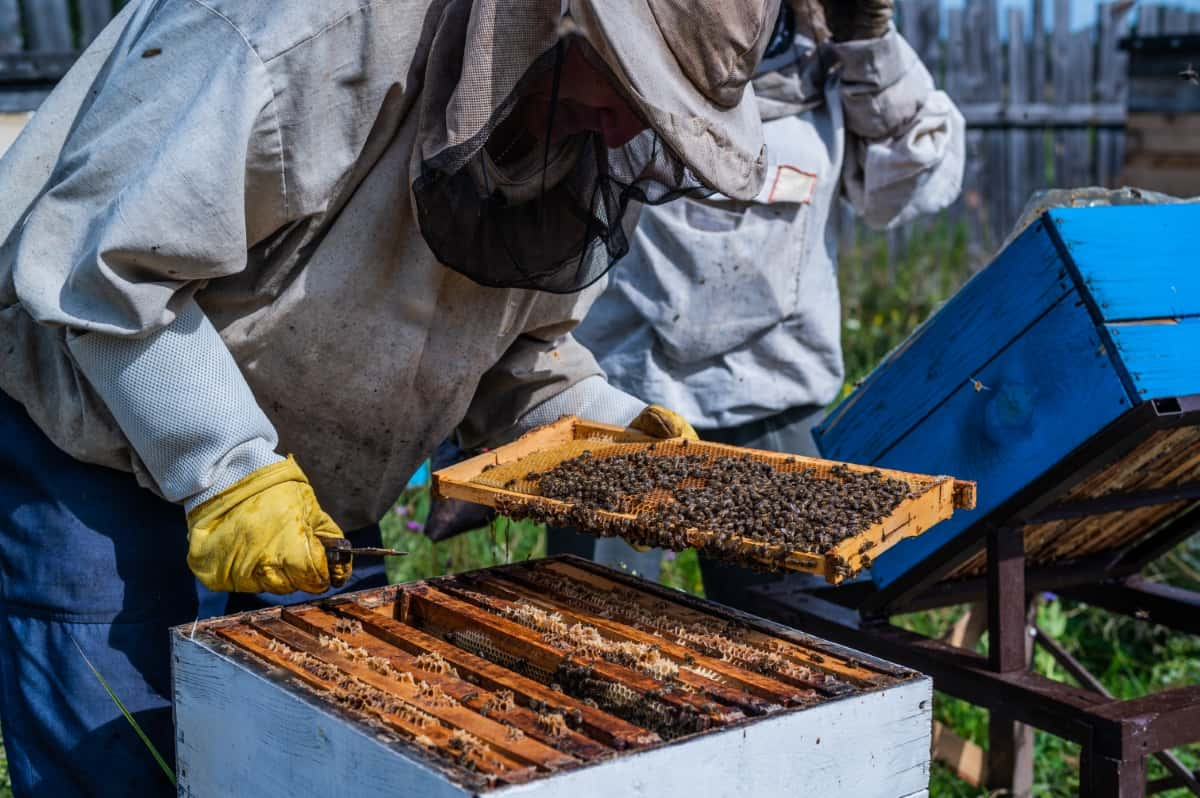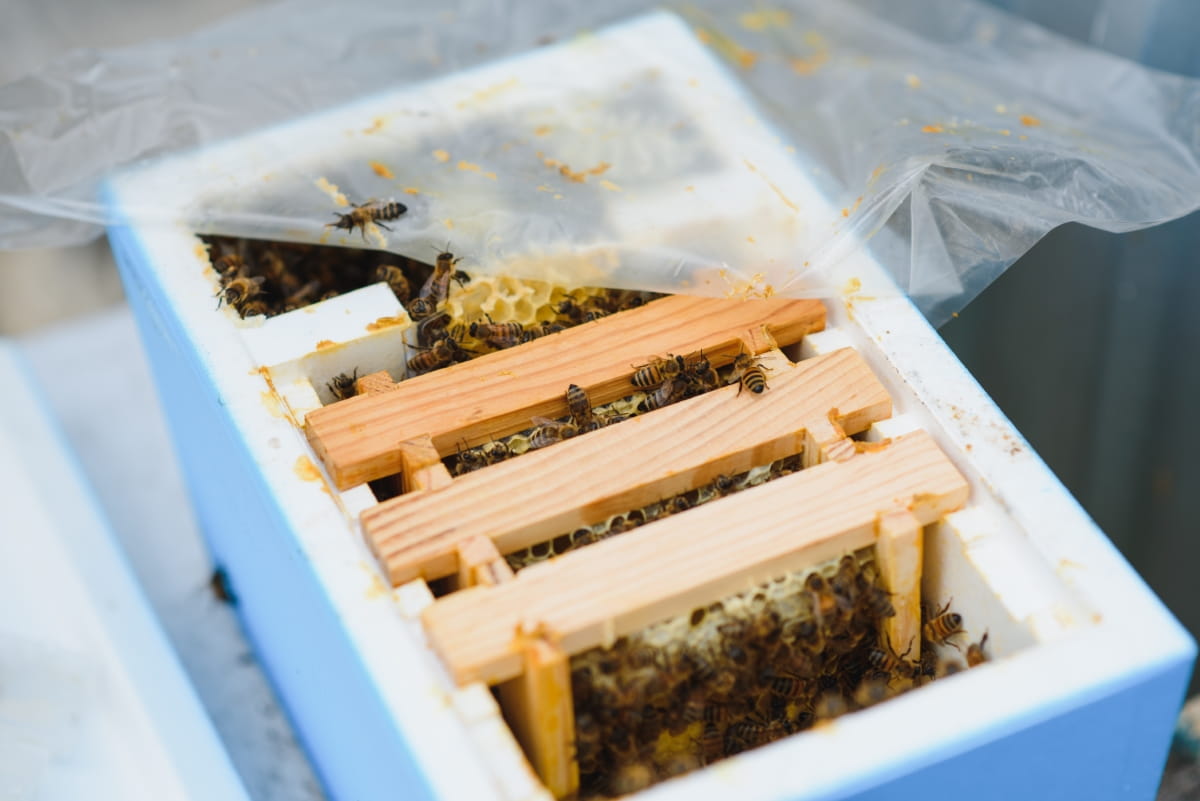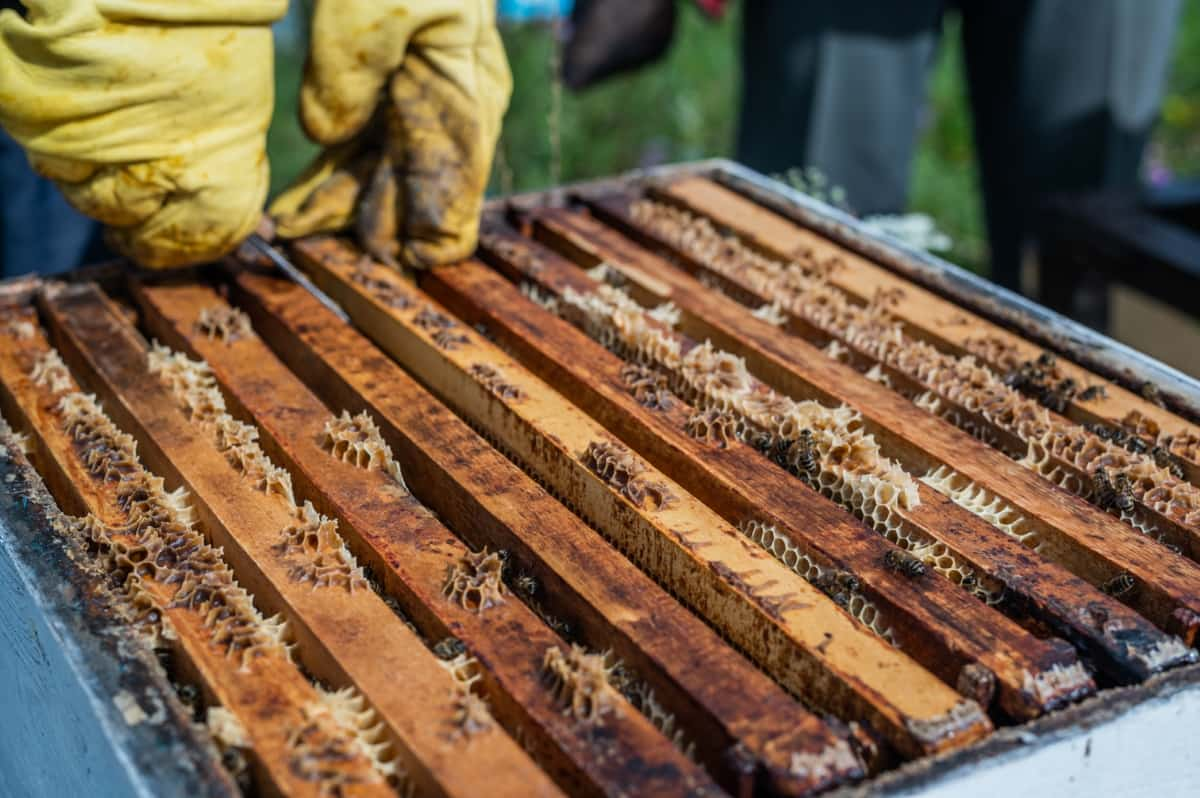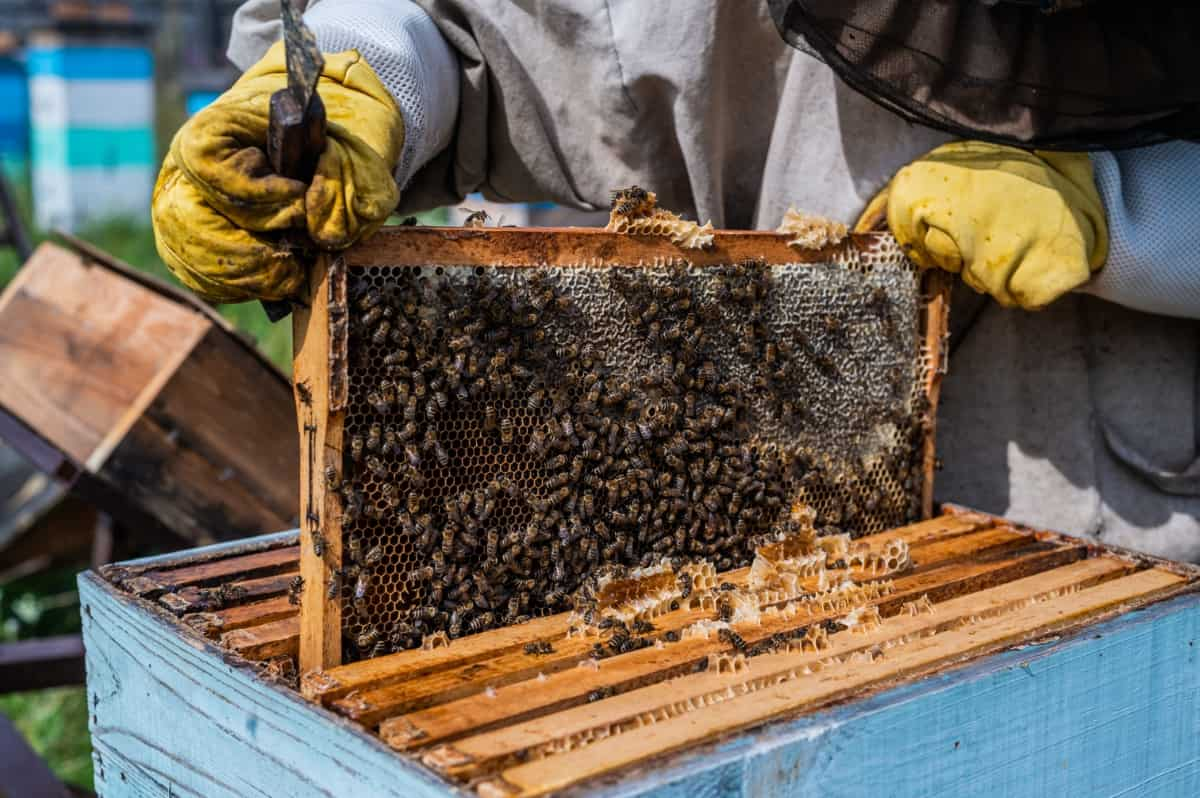Installing packaged bees is a crucial step in starting a new beehive. Whether you’re a beginner beekeeper or an experienced one, the process requires careful planning and execution to ensure the well-being and successful establishment of your colony. Here are the techniques, tips, and ideas involved in installing packaged bees.

How to Install Packaged Bees
Step-By-Step Guide to Safely Installing Packaged Bees in Your New Hive
- Begin by ensuring you have all the necessary equipment: a bee suit, gloves, a smoker, a hive tool, and a new hive with frames.
- Choose a calm, warm day for installation.
- Light the smoker and gently smoke the packaged bees to calm them.
- Remove the can of syrup and queen cage from the package.
- Spray the bees lightly with sugar water to prevent flight during installation.
- Remove frames from the hive to make space for the bees.
- Shake or pour the bees into the hive, ensuring the queen cage is accessible.
- Place the queen cage between two frames with the candy end up.
- Insert the remaining frames and close the hive.
- Provide a water source and monitor the hive’s activity.
- Wait 5-7 days before checking on the queen’s release. Your hive is now ready to thrive!
Essential Tips for Beginners on Installing Packaged Bees without Harm
- Prepare Equipment: Gather necessary tools – a bee suit, smoker, hive tool, and a spray bottle with sugar water.
- Choose a Calm Day: Install bees on a calm, sunny day to minimize stress.
- Wear Protective Gear: Always wear a bee suit, gloves, and a veil to protect yourself.
- Spray with Sugar Water: Lightly spray the bees with sugar water to calm them and make them easier to handle.
- Remove Queen Cage: Carefully remove the queen cage from the package, ensuring she is alive and well.
- Install Queen First: Place the queen cage inside the hive before releasing the worker bees.
- Gently Shake Bees: Tap the package to release bees into the hive, ensuring the queen is already inside.
- Close the Hive: Securely close the hive to prevent bees from escaping and to give them time to acclimate.
- Monitor Hive: Regularly check the hive in the following days to ensure the bees are adjusting well.
- Provide Food: Place sugar syrup near the hive to help the bees establish their new home.
How to Ensure a Successful Start: Techniques for Installing Packaged Bees
First, select a calm and sunny day for the installation to minimize stress on the bees. Spray the bees lightly with sugar water to deter flight, making them easier to handle. Prioritize a quiet location, away from disturbances. Install the package quickly but gently, ensuring the queen is released into the hive. Provide a sugar syrup feeder to support colony establishment. Regularly check for queen acceptance and monitor hive activity. Finally, maintain a consistent feeding schedule to strengthen the colony’s foundation for a thriving start.
In case you missed it: Small-Scale Beekeeping Cost and Profit: Investment, Economics, and ROI in Honey Bee Farming Business

Avoiding Common Mistakes when Installing Packaged Bees for the First Time
When installing packaged bees for the first time, common mistakes include improper hive preparation, such as not having frames in place or neglecting to feed the bees initially. Inadequate ventilation can stress the bees, as can rough handling during installation. Failing to release the queen properly or not ensuring she is accepted by the colony can lead to issues.
Insufficient protection against adverse weather conditions, like wind or rain, may also affect the bees’ survival. Neglecting to monitor and address signs of diseases or pests early on can jeopardize the hive. Beginners should prioritize thorough research and seek guidance to avoid these common pitfalls in packaged bee installation.
The Best Time of Year for Installing Packaged Bees
The ideal time to install packaged bees is during the spring, typically between April and May, when temperatures are consistently above 15°C. This period allows the bees to establish themselves in the new hive before the intense summer heat. Spring offers abundant blooming flowers, providing essential forage for the bees to build combs and gather nectar. It aligns with the natural reproductive cycle of bees, enhancing colony development. Avoid installing bees during colder months to prevent stress and ensure successful integration into their new environment.
Integrating Packaged Bees into an Established Apiary
When introducing packaged bees into an established apiary, ensure proper acclimatization to the existing hive environment. Place the package near the hive for a day, allowing bees to familiarize themselves with scents. Install the package gently, remove the queen cage, and release her after a few days.
Feed them sugar syrup to promote colony development. Regularly monitor for aggression or queen-related issues. Integrate frames with emerging brood to strengthen the colony’s bond. This gradual approach minimizes stress, fostering harmony between the new and existing bee populations, ultimately supporting a thriving and unified apiary.
Protective Gear and Safety Precautions for Installing Packaged Bees
- When installing packaged bees, prioritize safety with essential protective gear.
- Wear a full beekeeping suit, including a veil, gloves, and sturdy boots. Ensure the suit is sealed to prevent any bee entry points.
- Use a smoker to calm the bees and minimize aggression.
- Have a first aid kit on hand for potential stings.
- Prioritize a calm and methodical approach to reduce disturbance.
- Install bees during mild weather conditions, preferably in the evening when foragers are inside the hive.
- Have a water source nearby to distract bees if needed.
- Regularly monitor and maintain your gear to ensure its effectiveness in safeguarding against stings.
In case you missed it: Raising Bees for Pollination: Types of Bees Used, Challenges, and Best Practices

Maximizing Hive Health: Post-Installation Care for Packaged Bees
Ensure a water source nearby for hydration. Monitor and maintain proper ventilation to prevent overheating. Provide a sugar syrup solution to supplement their food source initially. Monitor the hive daily for signs of disease, pests, or a laying queen. Gradually introduce additional frames to expand their living space. Monitor and regulate the hive’s temperature as needed. Foster a calm environment during inspections to minimize stress. Stay informed about local flora forage to enhance their nutrition.
Troubleshooting Common Issues After Installing Packaged Bees
After installing packaged bees, common issues may arise. Ensure the queen is released, as delayed-release hinders colony development. Monitor food supplies; insufficient nectar or pollen can impede growth. Check for signs of disease, pests, or erratic behavior in the hive. Assess weather conditions, as extreme temperatures or sudden changes may stress the colony. Confirm proper hive ventilation to prevent overheating.
Evaluate hive placement, ensuring it receives adequate sunlight and protection from harsh elements. Regularly inspect comb construction, addressing any irregularities. If issues persist, consult experienced beekeepers or local beekeeping associations or seek professional advice to troubleshoot and maintain a healthy bee colony.
Eco-Friendly Practices for Installing Packaged Bees in Your Backyard Apiary
- Choose local bee suppliers to reduce transportation emissions.
- Opt for reusable, sustainable materials in hive construction, such as FSC-certified wood.
- Minimize disturbance to natural habitats when selecting apiary locations.
- Use organic and pesticide-free methods for hive maintenance to protect bee health and the environment.
- Encourage biodiversity by planting native flowers that support pollinators.
- Implement water-saving techniques and rainwater harvesting for hive hydration.
- Embrace natural pest control methods, avoiding harmful chemicals.
In case you missed it: Beekeeping in South Africa: Exploring the Apiculture Industry in South Africa

Conclusion
Remember, each beekeeper may have their preferences and variations in their approach. It’s essential to adapt these general guidelines based on your specific circumstances and the unique characteristics of your beekeeping location. Regular observation and a proactive approach to hive management contribute to the success of your beekeeping venture.
- Ultimate Guide to Ossabaw Island Hog: Breeding, Raising, Diet, and Care
- Ultimate Guide to Juliana Pig: Raising Facts, Size, Diet, Care, and Lifespan
- Raising Lleyn Sheep: Disadvantages, Price, Uses, Characteristics, and Care
- Ultimate Guide to Meishan Pig: Breed Facts, Breeding, Raising, and Care
- Ultimate Guide to Teacup Pigs: Raising, Diet, Lifespan, Cost, and Care
- Guide to Raising Poll Dorset Sheep: Facts, Profile, Characteristics, Uses, and Care
- Ultimate Guide to Bighorn Sheep: Characteristics, Diet, Lifespan, Breeding, and Lifecycle
- Ultimate Guide to Raising Katahdin Sheep: Farming Facts, Breed Profile, Uses, and Care
- Ultimate Guide to Raising Oreo Cows: Belted Galloways Farming Facts, Profile, Uses, and Care